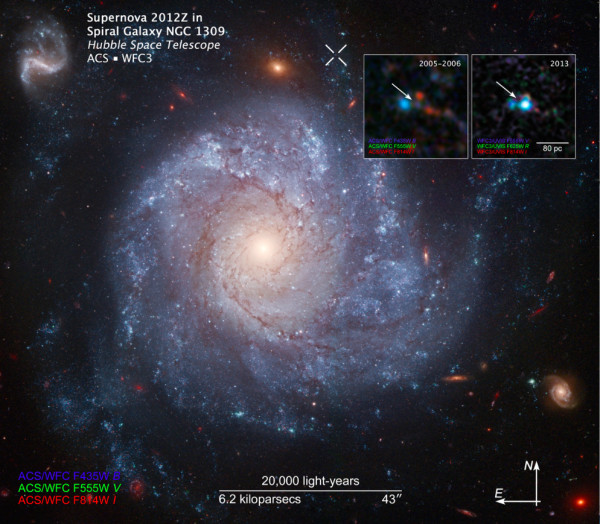
When we think of a supernova, we usually think of a massive explosion that wipes out the entire white dwarf star (dying stellar body). However, thanks to a collaboration of research scientists from leading American astronomers and astrophysicists and the Department of Physics and Astronomy, Aarhus University, we now know that isn’t always the case.
In galaxy NGC 1309, 110 million light-years from Earth, the Hubble Space Telescope has recently found that a weak supernova left something behind: part of a dwarf star, dubbed a “zombie star.” The discovery, A luminous, blue progenitor system for the type Iax supernova 2012Z, appeared yesterday in the journal Nature.
Over the past five years, astronomers have been making rapid progress searching for one of these zombie stars, a remnant of a Type Iax supernova produced by a carbon-oxygen white dwarf in a binary solar system. Scientist Saurabh Jha of Rutgers University in Piscataway, New Jersey, explains:
“Astronomers have been searching for decades for the star systems that produce Type Ia supernova explosions. Type Ia’s are important because they’re used to measure vast cosmic distances and the expansion of the universe. But we have very few constraints on how any white dwarf explodes. The similarities between Type Iax’s and normal Type Ia’s make understanding Type Iax progenitors important, especially because no Type Ia progenitor has been conclusively identified. This discovery shows us one way that you can get a white dwarf explosion.”
The Lick Observatory Supernova Search found SN 2012Z in the host galaxy in January 2012. Hubble’s Advanced Camera for Surveys also observed the galaxy for several years before the supernova, which enabled comparison of before-and-after images and identification of the zombie star that had lost its outer hydrogen envelope, revealing its helium core.
Here’s the astronomers’ theory about the game of seesaw between the bigger and smaller of the star pair:
“The more massive star evolved more quickly to expand and dump its hydrogen and helium onto the smaller star. The rapidly evolving star became a white dwarf. The smaller star bulked up, grew larger and engulfed the white dwarf. The outer layers of this combined star were ejected, leaving behind the white dwarf and the helium core of the companion star. The white dwarf siphoned matter from the companion star until it became unstable and exploded as a mini-supernova, leaving behind a surviving zombie star.”
Hubble found a similar but much weaker zombie star in January 2013 from supernova 2008ha, 69 million light-years away (galaxy UGC 12682). The findings of this study will be published in The Astrophysical Journal. Taken together, the work gives a sense of the wide range of possible effects of Type Iax supernovae.